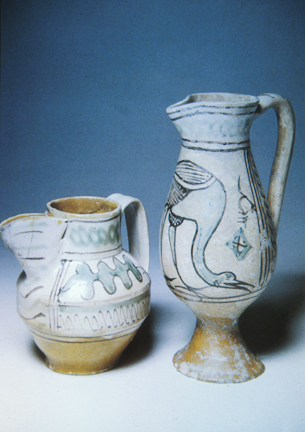
Two Pitchers, 'Maiolica Arcaica,' Earthenware with Tin Glaze and Oxide Decoration, Orvieto, Italy, 1300 CE
ART 198 - HISTORY OF WORLD CERAMICS
| Majolica (or Maiolica) is the name used to refer to pottery in which colored oxides are painted onto an unfired, opaque white glaze and fired to earthenware temperatures. The glaze used was similar to the lead based glazes used previously, but with the addition of tin oxide (Sn02), the glaze became opaque and an excellent surface for painted designs. An outgrowth of the Islamic ceramic tradition, this glaze was first introduced into Sicily, the large island to the southwest of Italy by immigrant Muslim potters from Northern Africa. Persian potters had originated the opaque, white glaze in the 9th century in order to cover their terra cotta clay with a surface more suited for painting. The white glaze also mimicked porcelain, another reason for its widening use among potters anxious to capitalize on the popularity of porcelain among the wealthy classes. In Islamic pottery, the white glaze serves as a background for the vivid luster painting seen throughout the Middle East, Northern Africa, and in the Hispano-Moresque pottery of Spain. Jugs such as these constitute a large proportion of the potter's output during this period, and were intended as ordinary table ware, and as such, little remains. The tin oxide used to opacify the glaze had to be brought in from England, and was expensive (as it still is today), and was only used on the exterior of pieces to provide a lighter painting surface. Note that on these two vessels, the inside and lower portions of the pots are glazed with a simple clear glaze, saving the expensive white glaze only for the painted parts of the pots. The early examples of the technique in Italy are referred to as 'maiolica arcaica,' literally meaning 'old maiolica.' Decorative motifs are derived from the natural world, as here, with the jug on the left painted with an oak leaf design, and the one on the right featuring a long-legged wading bird. Other subject matter included plants, geometric designs, zoomorphic figures, heraldic designs, and religious motifs. Only two colors were used in maiolica arcaica: green from copper used for solid areas, and purple from manganese used for outlining and cross-hatching. Pots were wood-fired in saggars to protect them from the flying wood ash. Maiolica arcaica would be replaced during the 15th century by polychrome majolica in which the color palette would be expanded. These were found in a rubbish pit in Orvieto. | Two Pitchers, 'Maiolica Arcaica,' Earthenware with Tin Glaze and Oxide Decoration, Orvieto, Italy, 1300 CE |
|
|